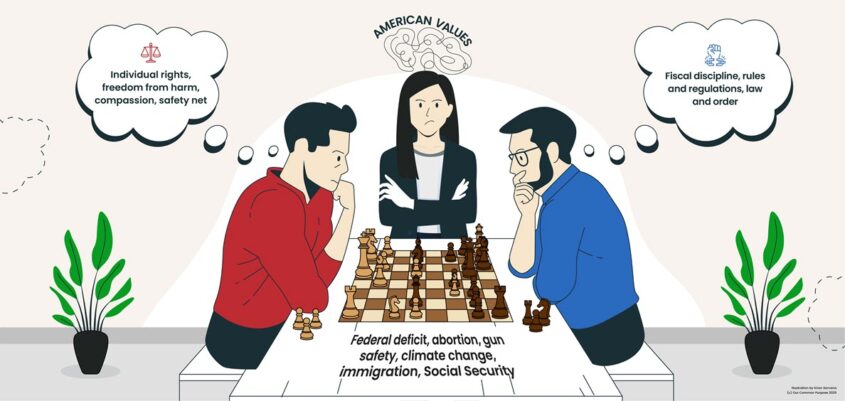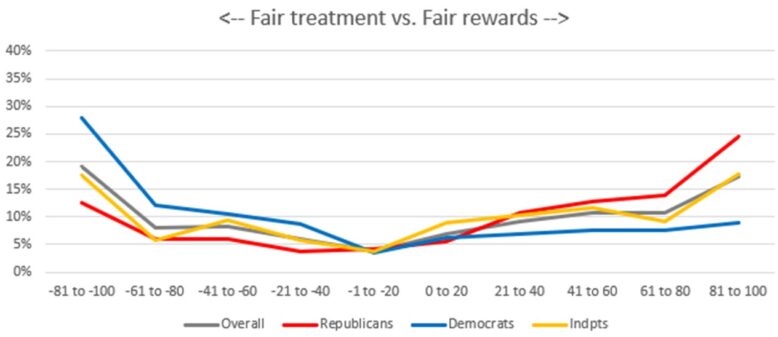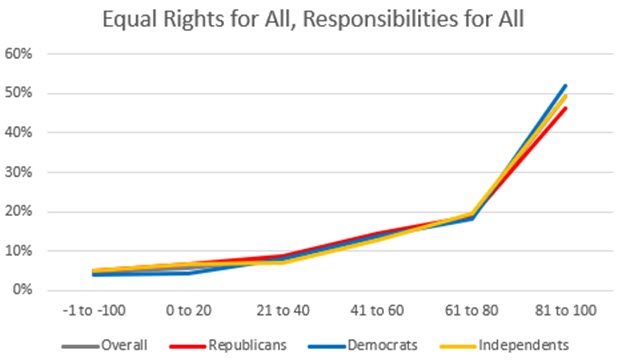More Than One Way to Deal with Conflicts in Values

Part VI of a series April 6, 2025
Donald Trump, in his first term, muscled up on the asylum seekers flooding our southern border. He began building a very large, very long wall and instituted a zero-tolerance policy that, in a particularly controversial move, separated children from their families.
Joe Biden came along and reversed those policies. He suspended work on the wall, re-opened the borders, established a task force that tried to reunite families, and reached a settlement that gave them more time to apply for asylum under a more favorable process.
Trump’s resumption of office has been marked by a return to more drastic measures. The military is now deployed along the border. Undocumented residents are being hunted down and deported.
These wild swings from one administration to the next leave much to be desired as the go-to method for establishing U.S. policy. For one thing, they’re increasingly accomplished by means of executive fiat. Biden’s executive order issued in his first days in office in 2021 revoked Trump’s executive order from 2017. Trump’s executive order on his first day in office this year revoked Biden’s executive order of 2021. Back and forth, tit for tat. The abrupt reversals forestall any constancy of purpose whatsoever. We begrudgingly go along, in the belief we don’t have much choice in the matter, while the situation becomes ever more dire.
It doesn’t have to be this way. Our method of establishing policy is just one of at minimum four forms of decision-making that, conceptually speaking, could be employed whenever our important values come into conflict, as they are bound to do. The inevitability of these conflicts is perhaps the key tenet of what’s known as values pluralism, the construct that guides Our Common Purpose in this study of American values.
Isaiah Berlin, the primary developer of this thinking, put forward two of the possible methods – which stand as polar opposites of each other – for how to address these conflicts as they arise.
Berlin desperately feared the first of his options. Reared in Russia, his early childhood was torn by the Russian Revolution. He emigrated to Great Britain at age 12, watched World War II firsthand as a member of the British Diplomatic Service, did his most important scholarly work post-war with Stalin and Hitler still top of mind. He feared a repeat.
A strong man could sweep into power, declare which values will be honored, issue sweeping edicts and expect everyone to toe the line because that is best for them. We can hope given our democratic traditions that we won’t have that, although we certainly are on the precipice. One need look no further than what already has been quite appropriately labeled the Trump tariffs. Not the U.S. tariffs, but the Trump tariffs. The last time tariffs of this magnitude were imposed it took an act of Congress to get it done. That by itself shows how much things have changed. As for other examples, if anything comes of annexing Greenland, the Panama Canal, Canada, it won’t be due to popular consensus. It will be the designs of one man.
The second of Berlin’s two options, to him the far preferable option, is at the other extreme. Faced with any conflict of values, every person should be allowed to decide for himself. This, in Berlin’s mind, constituted true freedom. It also amounts to a pure democracy, akin to town halls where every voter votes on every matter.
Oddly enough, the surveys conducted by Our Common Purpose serve as a proxy for what happens when the questions are such that respondents do not know the party line and are not told beforehand how to answer. The most recent poll, on which this study of American values is based, drew many comments along the lines of “the questions made me think.”
That’s a good thing, as far as it goes. The one major trouble being that with everyone going off in their own direction, we’d have chaos.
Inexplicably, Berlin stops at offering just these two options. One extreme or the other. Black or white, evil or good, no say or full say. The dichotomy, however, is much too simplistic. There are at least two additional alternatives.
One is the system we have today, so firmly entrenched that it’s hard to imagine anything else. Two sharply contrasting views of what’s best for the country vie for support. Those views championed by two political parties that spend lots of money and effort trying to woo folks into their respective camps. Voters caught in between have no choice but to choose between the two opposites.
And while one party or the other may gain only the barest majority at election time, the result is treated as winner determines all. The pendulum swings abruptly back and forth, the current go-around even wilder than most, as the winner undoes the policies of the other and enacts its own. The loser counts the days until the next election. The entire system encourages disagreement, not agreement.
The remaining option is what the Our Common Purpose initiative is all about. To find more lasting solutions, we have to bridge the gap, deliberately seek to find accommodation with each other. When conflicts in our important values arise, as they inevitably will, we have to actively look for ways to balance the good of one with the good of the other.
For instance, in Part IV of this series we looked at the conflict that for this initiative first arose in Superior, Neb., over what constitutes fairness. Some would define it as “fair and equal treatment.” Others contend it should be “fair rewards proportionate to effort.” These two versions are each significant enough to stand as values onto themselves.

And they tend to run headlong into each other. Our Common Purpose’s nationwide public opinion survey focusing on 25 key American values quantifies the considerable discomfiture when it happens. (The 2,500 respondents, who mirror the characteristics of the nationwide voting population, were asked in September by Survey USA to answer a lengthy set of questions using a sliding scale of -100 to +100.)
In this case, it’s a tough choice. The poll shows rampant disagreement on how to prioritize the two values. The differences are not just between political persuasions. When people are forced to think for themselves, as they are in the poll, there are intra-party divisions.

Well before having the public opinion surveys to bear out the results, Our Common Purpose sought to bridge this particular gap with this proposition: “Equal Rights for All, Responsibilities for All.” The statement became #6 in the 10 Principles to Unite America. The people in Superior liked it, and subsequent polling shows that it holds up extremely well across party lines.
True, this is just a high-minded ideal. It does, however, reflect the kind of tradeoffs that must be made to accommodate opposing views that came out of an active and intentional effort to bridge the gap. It’s not compromise per se; it’s acknowledgement.
This is what a large majority of Americans want. Faced in several of the Our Common Purpose polls with slightly different variations of the same basic question about what we want from our elected representatives, 70% or more of respondents say officials should give and take rather than stick to their own positions. In one of those polls, 93% said they should work it out rather than fight it out.
Our interests are not served by posturing, or arguing, or for that manner going silent. Our interests are best served by discussing whatever conflict in a constructive manner. The short-term benefits of striking a balance are keeping the peace and moving forward. The long-term benefit is lasting solutions that are acceptable to most, thereby averting constant reversals from one administration to the next.
Quite obviously, merely wanting this is not sufficient to magically make it happen. It will take commitment, structure, and real work, which is the enormous challenge for this approach.
Next: A promising structure for approaching such discussions

Very well-said. The challenge is finding politicians who will take on the conflict resolution mid-flight, as stronger voices drown them out.